Advertisement |
 |
Introducing Communications Chemistry: A new open access journal
Nature Research is excited to announce a new open access journal for the chemical sciences: Communications Chemistry.
Publishing high-quality primary research articles, reviews and commentary, papers published in the journal represent significant biological advances that bring new insight to a specialized area of research. All papers will be handled by experienced in-house professional editors and supported by an expert Editorial Board.
Find out more >> |  | |
 |
 |
TABLE OF CONTENTS
|
| December 2017 Volume 9, Issue 12 |
 |  |  |
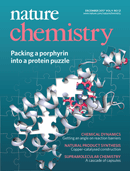 |  News and Views News and Views
 Articles Articles
 Retraction Retraction
 In Your Element In Your Element
| |
 |
| |
 |
 |
| Advertisement |
 |
npj Clean Water: open for submissions
An open access, online-only journal, dedicated to publishing high-quality papers that describe the significant and cutting-edge research that continues to ensure the supply of clean water to populations.
Explore the benefits of submitting your next manuscript. |  | |
 |
| |
Advertisement |
 |
npj Materials Degradation is a new open access journal that is now open for submissions. The journal publishes the finest content describing basic and applied research discoveries in the area of corrosion (degradation) and protection of materials.
Sign up for article e-alerts >>> |  | |
 |
| |
News and Views |  Top Top |
 |
 |
 |
| |
 |
| Advertisement |
 |
Do you have a career question?
The Naturejobs podcast features one-on-one Q&As, panel discussions and other exclusive content to help scientists with their careers. Hosted on the Naturejobs blog, the podcast is also available on iTunes and Soundcloud.
Listen today! |  | |
 |
| |
Articles |  Top Top |
 |
 |
 |
| De novo design of a hyperstable non-natural protein–ligand complex with sub-Å accuracy pp1157 - 1164
Nicholas F. Polizzi, Yibing Wu, Thomas Lemmin, Alison M. Maxwell, Shao-Qing Zhang et al.
doi:10.1038/nchem.2846
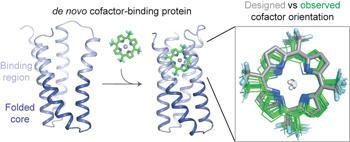
The first demonstration of a protein designed entirely from first principles that binds a small-molecule cofactor in a precisely predetermined orientation has now been described. The design method utilizes a remote protein core that both anchors and predisposes a flexible binding site for the desired cofactor-binding geometry.
|
 |
 |
 |
| Catalyst-controlled oligomerization for the collective synthesis of polypyrroloindoline natural products pp1165 - 1169
Christopher R. Jamison, Joseph J. Badillo, Jeffrey M. Lipshultz, Robert J. Comito and David W. C. MacMillan
doi:10.1038/nchem.2825
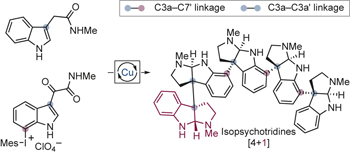
The collective synthesis of several oligomeric polypyrroloindoline natural products, including hodgkinsine, hodgkinsine B, idiospermuline, quadrigemine H and isopsychotridines B and C, is accomplished through the iterative action of an asymmetric small molecule copper catalyst. This strategy also enables the synthesis of putatively unnatural quadrigemine H-type isomers.
Chemical compounds |
 |
 |
 |
| Single-crystal-to-single-crystal intercalation of a low-bandgap superatomic crystal pp1170 - 1174
Evan S. O'Brien, M. Tuan Trinh, Rose L. Kann, Jia Chen, Giselle A. Elbaz et al.
doi:10.1038/nchem.2844
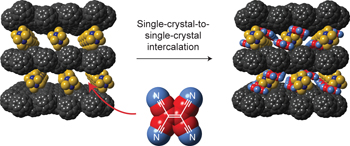
Intercalation — a cornerstone of materials science with wide-ranging applications — has now been demonstrated in a superatomic crystal. A redox-active tetracyanoethylene guest was inserted into the lattice of a material consisting of alternate layers of {Co6Te8} clusters and C60 fullerenes, leading to a single-crystal-to-single-crystal transformation that significantly modulates the material's optical and electrical transport properties.
See also: News and Views by Khanna & Reber |
 |
 |
 |
| Direct mapping of the angle-dependent barrier to reaction for Cl + CHD3 using polarized scattering data pp1175 - 1180
Huilin Pan, Fengyan Wang, Gábor Czakó and Kopin Liu
doi:10.1038/nchem.2858
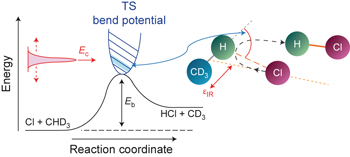
Two important properties in an activated chemical reaction are the barrier height and its geometrical dependence. Now, a method has been developed to directly map the angle-dependent barrier to reaction from polarized scattering data for the Cl + CHD3 reaction. The method should be applicable to many other direct reactions with a colinear barrier.
|
 |
 |
 |
| Global profiling of lysine reactivity and ligandability in the human proteome pp1181 - 1190
Stephan M. Hacker, Keriann M. Backus, Michael R. Lazear, Stefano Forli, Bruno E. Correia et al.
doi:10.1038/nchem.2826
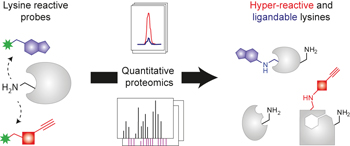
A chemical proteomic strategy has now been reported for the global profiling of lysine reactivity and ligandability. Using this approach, >9000 lysines in the human proteome were evaluated, leading to the discovery of hyper-reactive lysines, and lysines that can be targeted by electrophilic small molecules to perturb enzyme function and protein–protein interactions.
|
 |
 |
 |
| Supramolecular heterostructures formed by sequential epitaxial deposition of two-dimensional hydrogen-bonded arrays pp1191 - 1197
Vladimir V. Korolkov, Matteo Baldoni, Kenji Watanabe, Takashi Taniguchi, Elena Besley et al.
doi:10.1038/nchem.2824
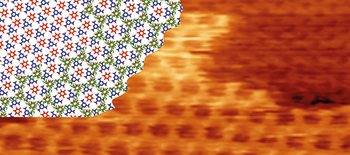
Supramolecular heterostructures have been formed by the sequential deposition of two molecular layers with different symmetries and lattice constants — one consisting of carboxylic acid, the other of cyanuric acid and melamine — on a hexagonal boron nitride substrate. Characterization by atomic force microscopy and molecular dynamics simulations shows epitaxial arrangements between the layers.
See also: News and Views by Buck |
 |
 |
 |
| Enantioselective cyclizations and cyclization cascades of samarium ketyl radicals pp1198 - 1204
Nicolas Kern, Mateusz P. Plesniak, Joseph J. W. McDouall and David J. Procter
doi:10.1038/nchem.2841
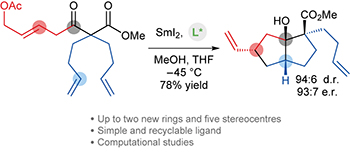
Although samarium-mediated cyclizations have the potential to generate significant molecular complexity, historically it has not proven possible to exert enantiocontrol through the use of a chiral ligand in complex product synthesis. Now, an enantioselective SmI2-mediated radical cyclization has been developed using a chiral aminodiol ligand. Desymmetrizing 5-exo ketyl-alkene cyclizations and cyclization cascades of unsaturated ketoesters deliver complex products and typically proceed with high enantioselectivity and diastereoselectivity.
Chemical compounds |
 |
 |
 |
| Vibronically coherent ultrafast triplet-pair formation and subsequent thermally activated dissociation control efficient endothermic singlet fission pp1205 - 1212
Hannah L. Stern, Alexandre Cheminal, Shane R. Yost, Katharina Broch, Sam L. Bayliss et al.
doi:10.1038/nchem.2856
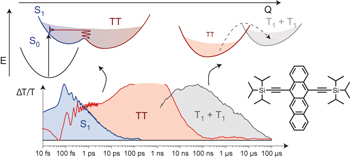
Singlet fission — the conversion of one singlet exciton into two triplet excitons, could improve the efficiency of photovoltaic devices — but its mechanism is still to be fully understood. Now, in films of TIPS-tetracene, it has been shown that the formation of the triplet pair state, which has been proposed to mediate singlet fission, is ultrafast and vibronically coherent in this endothermic fission system.
|
 |
 |
 |
| Site-selective oxidation, amination and epimerization reactions of complex polyols enabled by transfer hydrogenation pp1213 - 1221
Christopher K. Hill and John F. Hartwig
doi:10.1038/nchem.2835
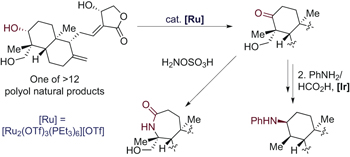
Polyoxygenated aliphatic chains with multiple hydroxyl groups are common in a wide array of compounds, often with potent biological activity. Now, a new ruthenium catalyst enables selective dehydrogenation of a single hydroxyl group in a broad scope of complex polyols. This site-selective modification facilitates the rapid incorporation of nitrogen-based functional groups into diverse natural products.
Chemical compounds |
 |
 |
 |
| Modular probes for enriching and detecting complex nucleic acid sequences pp1222 - 1228
Juexiao Sherry Wang, Yan Helen Yan and David Yu Zhang
doi:10.1038/nchem.2820

Modular hybridization probes (M-Probes) have been developed that enable sequence-selective binding of complex nucleic acid targets. The M-probes can target sequences that: are hypervariable at prescribed loci, are long continuous sequences of over 500 nucleotides, or contain repetitive sequences. A hybrid-capture assay using the M-probes was developed that was capable of determining the exact triplet repeat expansion number in the Huntington's gene from genomic DNA.
|
 |
 |
 |
| UV-light-driven prebiotic synthesis of iron–sulfur clusters pp1229 - 1234
Claudia Bonfio, Luca Valer, Simone Scintilla, Sachin Shah, David J. Evans et al.
doi:10.1038/nchem.2817
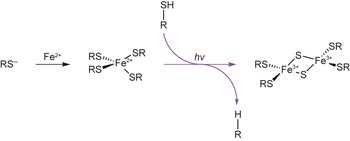
Current mineral-based theories do not fully address how enzymes emerged from prebiotic catalysts. Now, iron–sulfur clusters can be synthesized by UV-light-mediated photolysis of organic thiols and photooxidation of ferrous ions. Iron–sulfur peptides may have formed easily on early Earth, facilitating the emergence of iron–sulfur-cluster-dependent metabolism.
Chemical compounds |
 |
 |
 |
| A unifying paradigm for naphthoquinone-based meroterpenoid (bio)synthesis pp1235 - 1242
Zachary D. Miles, Stefan Diethelm, Henry P. Pepper, David M. Huang, Jonathan H. George et al.
doi:10.1038/nchem.2829
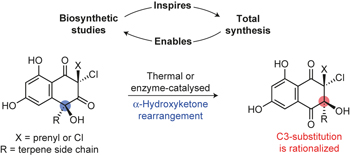
Bacterial naphthoquinone meroterpenoid natural products defy biosynthetic logic via classical biochemical paradigms. Now, an enzyme promoted α-hydroxyketone rearrangement catalysed by vanadium-dependent haloperoxidases reveals a conserved biosynthetic reaction in this molecular class that further has inspired a concise biomimetic synthesis of naphthomevalin, a prominent member of the napyradiomycin meroterpenes.
Chemical compounds |
 |
 |
 |
| Bicyclic Baird-type aromaticity pp1243 - 1248
Won-Young Cha, Taeyeon Kim, Arindam Ghosh, Zhan Zhang, Xian-Sheng Ke et al.
doi:10.1038/nchem.2834

Realization of the bicyclic aromaticity has attracted much attention because of the potential to modulate the fundamental properties of 3D aromatic organic molecules that are not topologically planar. Now, the synthesis and characterization of dual-aromatic molecules, and their electronically mixed [4n+1]/[4n+1] triplet bi-radical species displaying Baird-type aromaticity, has been realized.
|
 |
 |
 |
| Structure and reactivity of a mononuclear gold(II) complex pp1249 - 1255
Sebastian Preiß, Christoph Förster, Sven Otto, Matthias Bauer, Patrick Müller et al.
doi:10.1038/nchem.2836

Mononuclear gold(II) complexes are very labile (and thus very rare) species. Now, a gold(II) porphyrin complex has been isolated and characterized, and its reactivity towards dioxygen, nitrosobenzene and acids investigated. Owing to a second-order Jahn–Teller distortion, the gold atoms were found to adopt a 2+2 coordination mode in a planar N4 environment.
Chemical compounds |
 |
 |
 |
| Structural snapshots of concerted double E–H bond activation at a transition metal centre pp1256 - 1262
Joseph A. B. Abdalla, Alexa Caise, Christian P. Sindlinger, Rémi Tirfoin, Amber L. Thompson et al.
doi:10.1038/nchem.2792
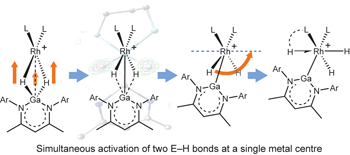
X-ray and neutron diffraction studies, in conjunction with quantum chemical techniques, have been used to define a new oxidative bond activation pathway that involves simultaneous activation of both bonds of a β-diketiminate-stabilized GaH2 unit at a single metal centre.
Chemical compounds |
 |
 |
 |
| Infrared spectrum and structure of the homochiral serine octamer–dichloride complex pp1263 - 1268
Jongcheol Seo, Stephan Warnke, Kevin Pagel, Michael T. Bowers and Gert von Helden
doi:10.1038/nchem.2821
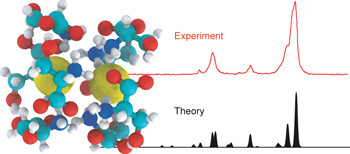
Octameric complexes of serine are long known for their special properties, such as their enhanced stability and preference for homochirality. Yet, there is no consensus on their structures. Now, experimental data on the serine octamer–dichloride complex is presented that supports a highly symmetrical, highly stable structure.
|
 |
 |
 |
| Catalytic diastereo- and enantioselective additions of versatile allyl groups to N–H ketimines pp1269 - 1275
Hwanjong Jang, Filippo Romiti, Sebastian Torker and Amir H. Hoveyda
doi:10.1038/nchem.2816

Amines are commonly occurring units in many biologically active molecules. Now, a catalytic method has been developed that merges an unprotected/unactivated ketimine, a monosubstituted allene and a commercially available diboron reagent to afford versatile α-tertiary amines in up to 95% yield, >98% diastereomeric ratio and >99:1 enantiomeric ratio. The utility of this method was demonstrated through its application to the synthesis of the tricyclic core of a class of compounds with anti-Alzheimer activity.
Chemical compounds |
 |
 |
 |
| Signal transduction in a covalent post-assembly modification cascade pp1276 - 1281
Ben S. Pilgrim, Derrick A. Roberts, Thorsten G. Lohr, Tanya K. Ronson and Jonathan R. Nitschke
doi:10.1038/nchem.2839

Two coordination cages have been devised that undergo covalent modification during a cascade of two orthogonal Diels–Alder reactions. This results in increased lipophilicity for the second cage, enabling its phase transfer and separation from the first. The trigger, relay and inhibition features of this cascade system mimic key aspects of natural post-translational modification cascades.
Chemical compounds |
 |
 |
 |
| Cooperative carbon-atom abstraction from alkenes in the core of a pentanuclear nickel cluster pp1282 - 1285
Manar M. Shoshani and Samuel A. Johnson
doi:10.1038/nchem.2840
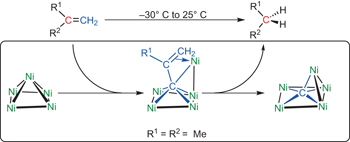
Interest in surface-mediated chemistry has led to the design of small molecule models for surfaces, which provide mechanistic insight and have practical applications. Now, the cooperative behaviour of five nickel centres has been shown to provide reactivity reminiscent of highly active metal surface sites, leading to carbon-atom abstraction from alkenes under ambient conditions.
Chemical compounds |
 |
| Advertisement |
 |
Searching for a new career?
At Nature Research we frequently recruit talented individuals to join our editorial and publishing teams. If you have a PhD and a passion for science this may be the perfect career for you.
Visit our research editorial and publishing careers website to discover more about what we do. |  | |
 |
| |
Retraction |  Top Top |
 |
 |
 |
| Retraction: Oligoarginine peptides slow strand annealing and assist non-enzymatic RNA replication p1286
Tony Z. Jia, Albert C. Fahrenbach, Neha P. Kamat, Katarzyna P. Adamala and Jack W. Szostak
doi:10.1038/nchem.2885
|
 |
In Your Element |  Top Top |
 |
 |
 |
| Thoroughly enthralling thulium p1288
Polly Arnold
doi:10.1038/nchem.2897
Named after a mysterious place, thulium — one of the rarest rare earths — has some exotic chemistry in store for us, says Polly Arnold.
|
 |
 Top Top |
 |
 |
 |
| Advertisement |
 |
npj Microgravity is a new open access journal specifically dedicated to publishing research which enables space exploration and research that is enabled by spaceflight and ground-based spaceflight analogues.
npj Microgravity is published in cooperation the Biodesign Institute at Arizona State University, and is part of the Nature Partner Journals series.
Find out more >>> |  | |
 |
| |
 |  |  |  |  |  | Natureevents is a fully searchable, multi-disciplinary database designed to maximise exposure for events organisers. The contents of the Natureevents Directory are now live. The digital version is available here.
Find the latest scientific conferences, courses, meetings and symposia on natureevents.com. For event advertising opportunities across the Nature Publishing Group portfolio please contact natureevents@nature.com |  |  |  |  |  | |
 |


No comments:
Post a Comment